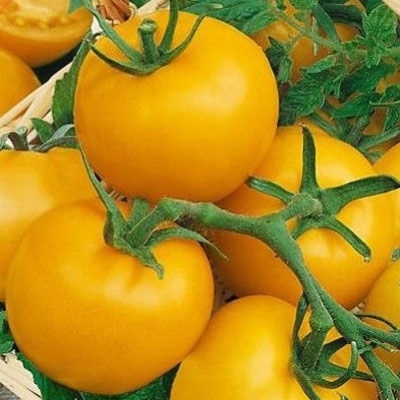
- Authors: Zhidkova V.A., Mikhed V.S., Altukhov Yu.P.
- Year of approval: 1996
- Category: grade
- Growth type: determinant
- Appointment: fresh consumption
- Ripening period: mid-early
- Ripening time, days: 101-122
- Growing conditions: for open ground, for film greenhouses
- Bush height, cm: 55-70
- Branchiness: medium
Dean's tomato variety can be used fresh, for pickling. It is permissible to grow it in small gardens, but it is also often used on large farms.
Description of the variety
Dina belongs to medium early varieties, the variety is medium branched. The height of an adult plant is about 55-70 centimeters. The leaf blades of the bushes are of medium size, they have a light green color. They have a peduncle with an articulation.
The main qualities of the fruit
These tomatoes have a simple rounded shape. Their color is orange. The surface of ripe fruits is smooth. The number of nests is 4-5. The weight of one vegetable can reach 100-130 grams.
The flesh of each fruit is quite fleshy. All of them are considered to be small-seeded. In addition, ripe tomatoes have a high carotene content.
Taste characteristics
Ripe vegetables have high taste characteristics. They will be suitable for salting, as well as for preparing various fresh dishes, including salads.
Ripening and fruiting
Dean's tomato is a medium early variety. Ripening times vary from 100 to 122 days. Under favorable conditions without temperature extremes and heavy cold rains, as well as when growing vegetables in greenhouses, the process of fruiting and ripening is faster.
Yield
The Dina tomato variety has a high yield level. From one healthy bush, you can get 3-4.5 kilograms of ripe vegetables. But it should be remembered that the composition and type of soil, the amount and timeliness of watering, the use of appropriate fertilizers, the implementation of preventive measures against diseases and pests, as well as the region of cultivation, have a great influence on the yield.
The timing of planting seedlings and planting in the ground
Sowing seed for seedlings should be done about 55-60 days before planting in open soil. It should be noted that such seedlings take root quite easily and quickly and almost do not get sick. As a rule, plants are planted in open ground after the end of frost in late spring.

Growing tomato seedlings is an extremely important process, because it largely depends on whether the gardener will be able to harvest at all. All aspects must be taken into account, from seedbed preparation to planting in the ground.
Landing scheme
For planting in the soil, only strong and healthy seedlings should be selected. For them, it is better to choose a place on the site that will be well lit by the sun, and will also be protected from the winds.
The soil should be either sandy or loamy. A distance of about 70 centimeters should be left between the rows with seedlings. A distance of about 40-50 centimeters is made between the bushes themselves.
The ground must be sufficiently loose. Loosening should be done every 3 or 4 days. In this case, the depth should not exceed 10 cm, so as not to damage the root systems of young plants.

Growing and care
In the process of growing such tomatoes, all weedy harmful vegetation should be removed in a timely manner. And also you will regularly need to apply special mineral fertilizers to the soil.
It is important to irrigate periodically. In rainy periods, the number of such procedures should be reduced, because waterlogging of the soil can lead to the appearance and development of various diseases, fungal infections. Do not forget about weeding and loosening the soil.




A plant needs different micronutrients at each stage of growth. All fertilizers can be divided into two groups: mineral and organic. Folk remedies are often used: iodine, yeast, bird droppings, eggshells.
It is important to observe the rate and period of feeding. This also applies to folk remedies and organic fertilizers.
Disease and pest resistance
Dean's tomatoes often suffer from late blight, as well as from watery, apical rot. In the first case, brown spots will appear on the leaves of the bushes. Over time, they begin to gradually transfer to the fruits, which further causes their deformation, rotting.
To cure late blight on tomatoes, you can use Bordeaux liquid, as well as special preparations ("Quadris", "Fitosporin"). When affected by watery rot, the pulp of the fruit begins to rot, forming a watery substance. To cure the vegetation, it is necessary to immediately remove all damaged parts, and also to carry out the treatment with strong insecticidal agents.
When plants are affected by apical rot, dark small spots appear on the top of the vegetables. Over time, they begin to press inside the fruit, the fruit becomes completely dry and rather hard. In this case, calcium nitrate can help.
Sometimes Dean's tomatoes are also affected by various insects, including Colorado beetles, ticks, and aphids. To get rid of such pests, you can use special preparations (Proteus, Confidor).
To prevent the appearance of various diseases on such a culture, it is necessary to carry out preventive measures in a timely manner. Often, tomatoes are treated with various folk remedies prepared at home, they also use ready-made preparations for prophylaxis, monitor soil moisture, and the general condition of the bushes.



























































































